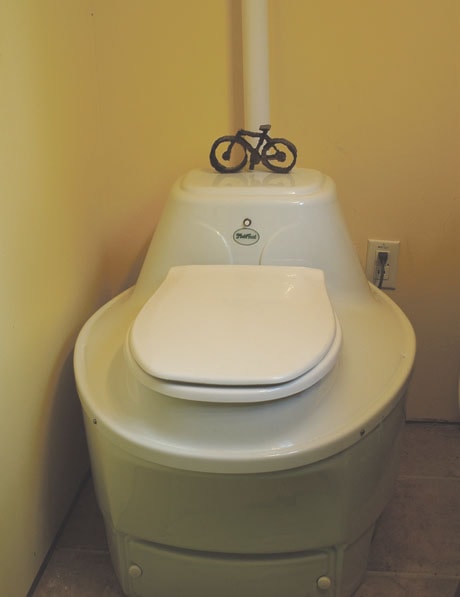When a kitchen fire destroyed the lakeside heirloom cottage of Mike and Alice Ogden back in June 2005, they decided to rebuild in a way that blended appropriately with the lakeside setting of their property, while also allowing the new cottage to become a year-round retirement home.
They built small (about 700 sq. ft.), and they opted for a composting toilet that posed no threat to the lake because it uses no water.
I’m the world’s least likely spokesman for composting toilets because of revolting childhood experiences I endured thanks to two ill designed units we had at our family cottage.
But as it turns out, the realities of a growing number of flush toilets in cottage country is pretty ugly, too.
This fact has kept me from giving up on composting toilets altogether, and it’s a good thing. While development pressures in cottage country have increased over the last few decades, composting toilets have become a whole lot better in ways that might surprise you.
At first glance, composting toilets are probably the world’s least glamorous product.
What else can you say about a hefty, box-like receptacle that sits in your bathroom and processes month’s worth of human waste right next to the shower?
But after 40 years of first-hand experiences in cottage country — both loving it and fearing for its future — I’m here to make the case for the humble, much-maligned composting toilet.
I’m convinced that no other single piece of household technology offers greater promise for keeping cottage country green, and this fact is true in not just one way, but two.
No matter how little water a flush toilet uses, it’s still pollutes water.
Lots of it over the course of a year. And if the waste system designed to treat toilet water malfunctions in any way, the quality of surrounding lakes and rivers will suffer.
Composting toilets, on the other hand, don’t produce dirty water, so they eliminate all risks of contamination.
Most of the basic, self-contained models include a heated, ventilated chamber directly below the toilet seat.
Waste is stored, dried and aerated there with a roof-mounted vent drawing odours outdoors. The result is harmless, soil-like compost that’s removed from a sliding tray every six to 12 months.
Larger composting toilet systems include a remote composting chamber that’s well suited to year-round use.
And unlike my loathsome childhood experiences, a number of modern composting toilets actually perform like they’re supposed to.
Mike and Alice have been using a Swedish-made Mulltoa 60 for the last three years, and they’re completely pleased with its performance.
“It’s worked perfectly,” says Mike, “even when we’ve had a bunch of guests camped out in the yard and coming in to use the bathroom.
“There’s been no odour, no leakage and nothing to threaten the lake.”
Another drawback of flush toilets in cottage country is the disruption involved in creating a traditional septic system to treat all the polluted water they create.
This often means cutting down at least 1,000 sq. ft. of forested land (sometimes much more), then hauling in truckloads of fill to create a raised weeping bed.
This is where partially purified water trickles through the soil to clean it up.
Besides costing many thousands of dollars, weeping beds are always visually devastating in a forest landscape.
That’s the second reason composting toilets make sense. Weeping beds need to be seeded, mowed and kept free of trees and bushes forever. “We simply weren’t prepared to cut down the forest next to our cabin just so we could have a flush toilet,” explains Mike. “That would be wrong.”
Somewhere out there is a point where modest human expectations converge with appropriate technology to create a sustainable lifestyle. I don’t know exactly what this looks like in every area of life, but when it comes to cottage country and toilets, I’m convinced that a good composting toilet comes very close to the ideal.
Steve Maxwell is Canada’s award-winning home improvement expert, and technical editor of Canadian Home Workshop magazine. Sign up for his free homeowner newsletter at www.stevemaxwell.ca
